
Chess in the classroom? Teachers and parents have discovered the educational benefits, and the trend is growing rapidly. And they are in good company.
On June 13th, 2014, Bono called his time as a scholastic chess player as his "... greatest childhood pleasure. In Ballymun we had a chess club, and like so many kids at the beginning of the 70s, I fell head over heels for this dizzy strategic game."
A week before, Richard Branson, founder and chairman of Virgin Group, was promoting chess as well -- he nominated chess as the best game in the world. Branson said, “It would be wonderful if everyone in the world could enjoy the competition and sense of achievement chess can provide.” The week after Bono's post on June 19th, the Chess Caucus of the United States Congress held its first bi-partisan chess tournament with the goal of promoting chess in education. Helping the congress members with their games were some of the top scholastic chess players in the United States.
Why has this summer seen so much excitement about chess and education? And why would a scholastic chess club have the kind of impact that Bono describes?
If scholastic chess is a gateway to STEM education, then scholastic chess clubs are the path through that gateway for many young would-be chess players. These clubs meet in the school, meet regularly and are among friends. They are more like a sport club than an academic club, especially when the club encourages sanctioned tournament play. While some students learn chess during regular school hours -- for example, Armenia requires chess as part of the school curriculum and the Dalton School in New York City teaches chess to all kindergartners -- extra-curricular scholastic chess clubs are the most readily available venue for many young beginning chess players.
Scholastic chess clubs grow scholastic chess. Here's why that's worthwhile:
- Now more than ever, lots of kids like to play chess.
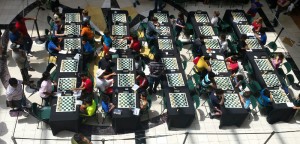 "You can expect 10-15% of an elementary school's students to show up when you announce a chess club," says Bill Clausen, Executive Director of Chess Achieves. Some parents at my local elementary school chess club have even told me that they can use chess club attendance as a reward and many of our players are noticeably bummed when chess club wraps up for the year. In contrast, lectures on mathematical and logical concepts probably aren't going to excite and engage young kids in the same way. A chess club, then, is a venue for an activity that is drawing in more and more kids, especially those that discover chess on tablets and home computers. In the context of the hundreds of years of chess history, the relatively new era of the tablet computer is an exciting development that is leading to a surge in interest among young digital natives.
"You can expect 10-15% of an elementary school's students to show up when you announce a chess club," says Bill Clausen, Executive Director of Chess Achieves. Some parents at my local elementary school chess club have even told me that they can use chess club attendance as a reward and many of our players are noticeably bummed when chess club wraps up for the year. In contrast, lectures on mathematical and logical concepts probably aren't going to excite and engage young kids in the same way. A chess club, then, is a venue for an activity that is drawing in more and more kids, especially those that discover chess on tablets and home computers. In the context of the hundreds of years of chess history, the relatively new era of the tablet computer is an exciting development that is leading to a surge in interest among young digital natives. - Scholastic chess has been linked to better academic performance. The Yamie Chess project, a supplementary K-8 math learning program based on classic chess that strives "to help children master the prerequisite and specific mathematical thinking tools they will need for later study in STEM (science, technology, engineering, and mathematics) areas," has a great web page that links to a lot of research about scholastic chess. The United States Chess Federation (USCF) also provides a Chess Research Bibliography with over 40 articles. The overall body of research includes studies with control groups that show significant benefits for students regularly participating in a chess program, including:
- " In contrast to the comparison group, it was found that chess improves cognitive abilities, coping and problem-solving capacity, and even socioaffective development of children and adolescents who practice it." -- Aciego, R. (2000) The benefits of chess for the intellectual and social-emotional enrichment in schoolchildren. The Spanish Journal of Psychology. 2012 Jul;15(2):551-9
- "Students in a New York City chess program improved reading scores more than a control group...the chances are only one in a hundred that these gains were due to chance." -- Margulies, S. (1991). The Effect of Chess on Reading Scores: District Nine Chess Program Second Year Report - Chess-In-The-Schools, New York, NY (USA)
- "Regular (non-honors) Elementary students who participated in a school Chess Club showed twice the improvement of non-chess players in Reading and Mathematics between third and fifth grades on the Texas Assessment of Academic Skills." -- Liptrap, J. (1997). Chess and Standardized Test Scores, Chess Life, March 1998, pages 41-43 - Klein Independent School District, Spring, Texas (USA)
- "Analysis of covariance (ANCOVA) results show the chess playing group (11 females, 9 males) scored significantly higher than the control group (10 females, 10 males) in mathematics achievement." -- Smith, J. P., & Cage, B. N. (2000). The Effects of Chess Instruction on the Mathematics Achievement of Southern, Rural, Black Secondary Students. Research in the Schools, 7, 19-26
If you are on the fence about getting involved with scholastic chess, then maybe the research can help you with your decision. Alternatively, you could conduct your own field research by visiting a scholastic chess tournament or club in your area.
- Timed chess teaches time management. Most of the world's serious chess games are regulated by chess clocks. At it's simplest and most common, each player has a set amount of time to make all of their moves. 30 minutes for all of a player's moves is typical at weekend scholastic chess tournaments. Those can last, at maximum, just short of an hour. Both tests and chess games are a series of problems to be solved. In both cases, a student benefits from time management at minute and even second granularity.
- Explore the mathematical beauty of chess with hundreds of years of analysis and an endless supply of puzzles.
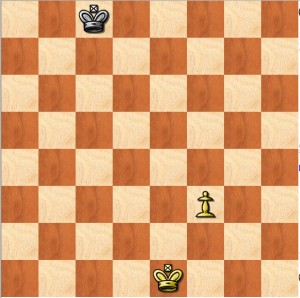 At right is a puzzle I taught this spring at my elementary school chess club. I got it from Susan Polgar's lecture "Master more advanced end games!" and I presented it as 'checkmate in 22 or so moves'. If black plays accurately, white has only one correct move to win and gain 1 point. Any other move by white leads to a draw and only 1/2 point. This puzzle is similar to handing someone a Rubik's Cube. It traverses several concepts, including stalemate, zugzwang and a geometry lesson called "rule of the square," which are applicable well beyond chess.
At right is a puzzle I taught this spring at my elementary school chess club. I got it from Susan Polgar's lecture "Master more advanced end games!" and I presented it as 'checkmate in 22 or so moves'. If black plays accurately, white has only one correct move to win and gain 1 point. Any other move by white leads to a draw and only 1/2 point. This puzzle is similar to handing someone a Rubik's Cube. It traverses several concepts, including stalemate, zugzwang and a geometry lesson called "rule of the square," which are applicable well beyond chess.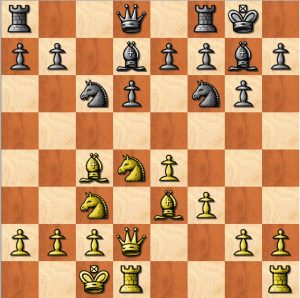 More tactical checkmate-in-one puzzles can be found at mateinone.com and in László Polgár's giant book "Chess: 5334 Problems, Combinations and Games," shown in the last picture of this blog post.
More tactical checkmate-in-one puzzles can be found at mateinone.com and in László Polgár's giant book "Chess: 5334 Problems, Combinations and Games," shown in the last picture of this blog post.
On the other end of the game are the 'book' openings, like the Sicilian Dragon shown at left. It is one of many orthodox openings that results in an even game after the first few moves. Advanced players will study actual books like Eric Schiller's "Standard Chess Openings" or study online at a site like www.chess.com. At my elementary school club, students like to work through the Frankenstein-Dracula Opening and the Fried Liver Attack, because, you know, the names. - Chess has a long, rich and living history that excites young players. The examples above are just
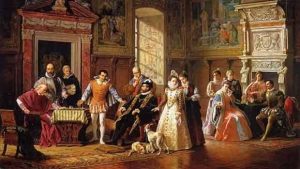 a couple from the rich history of puzzles, theory and analysis. That history includes a fascinating cast of characters such as Ruy López de Segura. He was born in 1530, participated in the first known international chess tournament (pictured at right) and published an important early book on chess. We remember him today because of the Ruy Lopez opening, aka the Spanish opening, one of the most popular chess openings and a favorite of mine. Fast forward to present times and you have chess's first social media generation, including:
a couple from the rich history of puzzles, theory and analysis. That history includes a fascinating cast of characters such as Ruy López de Segura. He was born in 1530, participated in the first known international chess tournament (pictured at right) and published an important early book on chess. We remember him today because of the Ruy Lopez opening, aka the Spanish opening, one of the most popular chess openings and a favorite of mine. Fast forward to present times and you have chess's first social media generation, including:
- Magnus Carlsen, the 23 year-old reigning World Chess Champion as well as the reigning World Champion in rapid and blitz chess.
- Susan Polgar, Grandmaster, chess champion, blogger of daily chess news and coach of the Webster University Men's Collegiate Chess Team, the reigning College Chess Final Four champions.
- Claudia Muñoz, perennial national top-ten player, recent winner of the 2014 US Junior Girls Invitational, bi-lingual blogger. And high school student.
- Experience the thrill of rated tournament play. Once your club is off the ground, your players can enter a sanctioned tournament and earn an
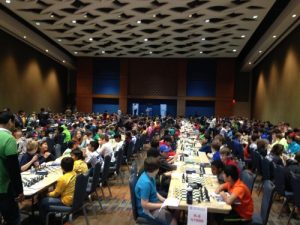 internationally recognized chess rating from a FIDE sanctioned body like the USCF. Once a player is rated, the rating system ensures that they will be matched with similarly rated players so that they play even games. Competitive players, of course, want to move up in the ratings. The middle school chess club at Brooklyn, NY's Intermediate School 318, arguably the top scholastic chess club in the nation and made famous by the movie Brooklyn Castle, has seen some middle school students move so far up in the ratings that they become Masters.
internationally recognized chess rating from a FIDE sanctioned body like the USCF. Once a player is rated, the rating system ensures that they will be matched with similarly rated players so that they play even games. Competitive players, of course, want to move up in the ratings. The middle school chess club at Brooklyn, NY's Intermediate School 318, arguably the top scholastic chess club in the nation and made famous by the movie Brooklyn Castle, has seen some middle school students move so far up in the ratings that they become Masters. - Help players earn enormous and fantastic chess trophies. Like most any sport, the top players are rewarded with trophies and recognition, and a few go on to play competitive chess professionally. Though the bucket of available scholarship money isn't anywhere near that of a top tier NCAA sport like basketball or football, scholarships based on scholastic chess excellence are out there. A more realistic goal is earning a trophy based on a top tournament finish.They are huge. And not guaranteed.
- Bring home team trophies for your school. Many tournaments offer team competition in addition to individual competition. Team chess is like team tennis -- individuals play regular one-on-one games that aggregate to a team score. Team tournaments are a great way to engage first-time tournament players and players that aren't as driven by individual competition.
- Help your players achieve strategic goals with study. Competitive chess rewards study, but tournament play isn't the only way that chess study can be rewarding. Last spring at my local elementary school chess club, the most studious player wasn't preparing for a game against another kid in a scholastic chess tournament. She was getting ready for the next game against her grandfather. Other players consistently preferred solving chess puzzles to competitive over-the-board play. Some players enjoyed making puzzles, and a 4th grader provided the three checkmate-in-one puzzles that spell 'Why?' above. The study of chess can be engaging and rewarding in and of itself, and not just as part of tournament preparation.
- It's a game of the ages, for all ages. Chess has been with us for hundreds of years. The rise in computing power has not stopped chess, it has helped the
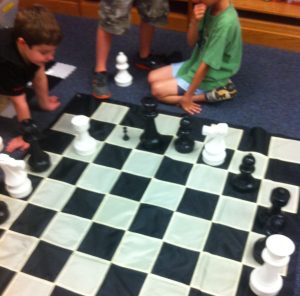 game. Chess is played all over the world by all kinds of people of all ages. It's played in parks all around the world on large chess boards, and large chess boards can even be brought in to the classroom as shown at the left. It is a common language that is used in different branches of mathematics and problems like the Knight's Tour and the 8 Queens Puzzle show up in college classrooms. Chess isn't a fad or a flash-in-the-pan. You are always able to find someone to play with online and will often find a tournament or club in your area. A player's investment in chess will likely pay dividends for a lifetime.
game. Chess is played all over the world by all kinds of people of all ages. It's played in parks all around the world on large chess boards, and large chess boards can even be brought in to the classroom as shown at the left. It is a common language that is used in different branches of mathematics and problems like the Knight's Tour and the 8 Queens Puzzle show up in college classrooms. Chess isn't a fad or a flash-in-the-pan. You are always able to find someone to play with online and will often find a tournament or club in your area. A player's investment in chess will likely pay dividends for a lifetime.
More and more digital natives are coming to chess. Scholastic chess clubs provide venues so that they can gain the benefits of the ancient game. We need more of them so that we can properly leverage the historic chess bubble being driven by tablets and home computers. In a previous blog post, I discussed some technological options that can help us handle the bubble, but they aren't here yet. To get more scholastic chess clubs, we need more volunteers that are willing to step up and step out of their comfort zones. Then, we can STEM-ulate more of these young minds.
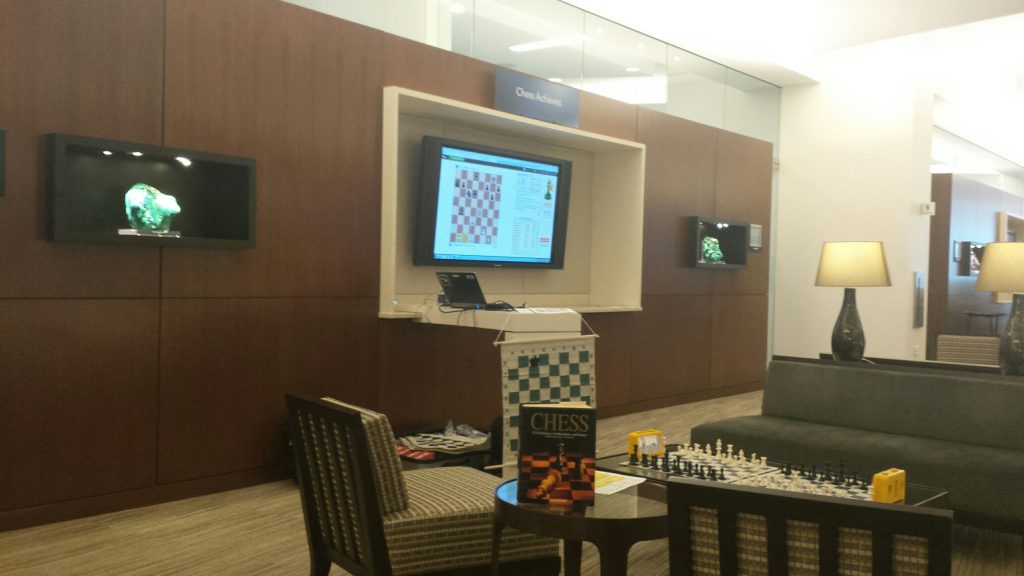
Image: Ruy Lopez at first international chess tournament, "Leonard di Cutri defeats Ruy Lopez in Spain" by Luigi Mussini //License: Creative Commons Attribution-Share Alike via Wikimedia Commons

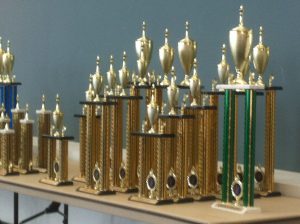

5 Comments
Wonderful items from you, man. I have take into accout your stuff prior to and
you are simply extremely great. I actually like what you've acquired here, certainly like what you're saying and the way
in which you say it. You're making it entertaining and you continue to
care for to keep it sensible. I can't wait to read much more from you.
This is actually a great web site.
My page :: Google
Ok, I'm 78 years old and would love to be able to play chess with my 6th grade granddaughter. Is there a way I could get your curriculum guide so I could teach myself first? I have a weak background in math, but I am a fast learner and a good reader. Thank you for your help...please.
There are lots of ways to learn chess and to teach it to grade schoolers. If you are here in the Research Triangle Park area of North Carolina, check out http://trianglechess.com/ They offer a variety of programs and have just opened a new space.
The website chess.com has a nice interactive page on the basics: http://www.chess.com/learn-how-to-play-chess
Yamie Chess, which is mentioned in this post and has a great page on chess research, provides a fun way to learn chess and ties in to STEM and math education: https://www.yamiechess.com/
You'll also find books on chess at book sellers like Barnes & Noble and Amazon.
My method to teach chess is to talk about each piece independently. I start with the simple pieces, in this order: king, rook, bishop and queen. Queen = rook + bishop. I'll do some checkmate-in-one exercises with the simple pieces. Then I cover the complex pieces: knight and pawn. Then the 'special rules' and then it's time to play a game with lots of talking about what is going on.
You can find chess clubs scholastic and adults near you:
http://wheretoplaychess.info/
My son has been begging me if he could join the chess club at his school, and I have been wondering if it's even worth trying to squeeze into our busy schedule. After looking up some of the facts, I've been surprised with what I've found. Like you said, chess has been linked to a better performance in school, especially in math, science, and engineering. My son is already pretty good at math, but if putting him into a chess clubs helps improve those skills, that would be well worth it to me.